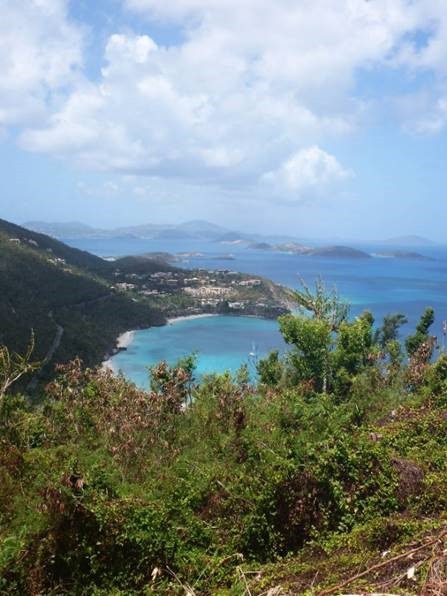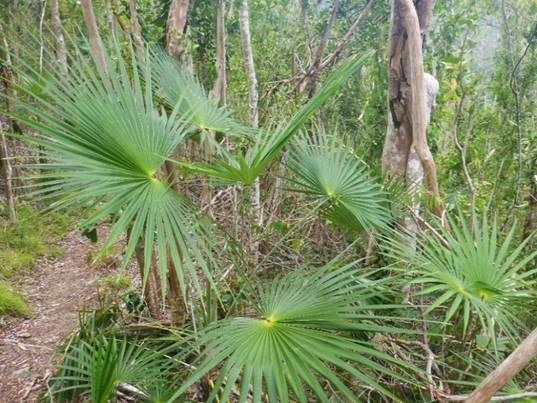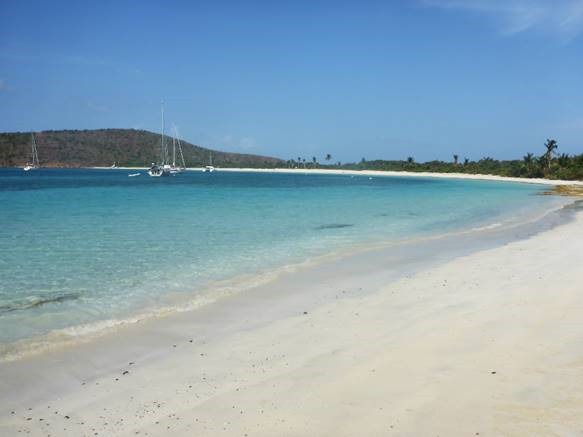19 April - the last Virgins

|
18:19.13N 065:13.7W On Monday 16 April we moved a few hundred yards along the coast of St John into Cinnamon Bay, where there were a couple of Park Trails open. We donned our walking shoes and set off. The beach was long and deserted, fringed with palm trees, mangroves and steep hills. We landed at an abandoned campsite, trashed in the hurricane and with few signs of regeneration. It was easy enough to reach the road, where we found a ruined Danish sugar factory dating from the nineteenth century. The Parks Service had done a good job in laying out an informative trail through it and for once it was interesting so see how the industrial archaeology had survived the storm quite well, whereas the signs inviting you to look for various highlights of local flora and fauna now seemed redundant, such was the destruction. I read somewhere about an island with a colony of monkeys who were all drowned and washed ashore on an adjacent island; here, there were plenty of very small lizards, a few birds in the overhead canopy, plenty of new undergrowth springing up, but overall a sense of massive change to the natural order. We climbed several hundred feet up ‘America Hill’ to the ruin of a fine sugar plantation mansion with great views across to Tortola in the East and St Thomas in the west. Following its heyday in the 1850s, the end of slavery and the rise of beet as a source of sugar rather than cane, it had finally been abandoned in the 1940s, after serving as a guesthouse and a store for bootlegged liquor. Apparently, the cost of repairs following a series of hurricanes complicated by the difficult access and a shortage of fresh water, finally put paid to what must have been a glorious home.
Cinnamon Bay, with Escapade at anchor, looking towards St Thomas We returned to Charlotte Amalie to ‘check out’ of the US Virgin Islands and push on towards Puerto Rico. We had a good wander through the old town, which is well preserved with many of the old Danish warehouses tastefully converted into sophisticated retail shopping areas, all aimed at the cruise ship market. There were similarities with Dutch St Maarten, but Charlotte Amalie seemed more tasteful, more upmarket. We managed to speak to the Onan agent in San Juan and arranged to pick up the generator spares I needed on Friday. Hastily, we arranged a marina berth in Puerto del Rey, a hire car and a hotel for the night in San Juan.
Tyre palms, used for making fish traps. St John, USVI Admin complete, we sailed for the Puerto Rican island of Culebra, part of the Spanish Virgin Islands. It’s off the beaten track, not least because for many years the US military used Culebra and nearby Vieques for live firing exercises. As a result, much of the most beautiful, more remote areas of the islands remain off limits as the US Army Corps of Engineers gradually clear unexploded ordnance from the beaches and countryside.
I think they missed this fellow! Why did they leave? A mixture of environmental lobbying, residents of the islands wanting their land back, budgetary cuts in the Department of Defense, and some well-meaning attempts to replace live firing practices with computer simulation. In my opinion, whilst it definitely has its place in the training curriculum, simulation is a very poor alternative for those aspects of training which require operators to respond to real world pressures: I have not found a computer simulator that replicates the noise, heat, smell, adrenalin and organised chaos of live weaponry, let alone the pressures of equipment failures, changes to the plan or the weather, poor map reading, lack of stores support, seasickness, RAF timekeeping…
Ensenada Honda, Culebra. About as untouristy as you can get! We enjoyed a fast, straightforward downwind sail of about 20 miles under spinnaker to Culebra, where we anchored in the Ensenada Honda, a fine inlet guarded by reefs at the seaward end. It’s not spectacular and the infrastructure is pretty basic, but the place was friendly and laid back. We went ashore in the morning to clear Customs. It transpired that we needed to go to the airport to do this, so we set off in the dinghy along the foreshore to find a suitable landing place. There was a chap painting his dock in front of his home; we asked him for advice and two minutes later were secured alongside his rebuilt mooring and being offered any assistance we could have wished for. Antonio lives on the mainland of Puerto Rico, but escapes here at weekends for the peace and quiet. He has great taste in Latin jazz and I envied the chilled simplicity of his lifestyle. Clearing up after the hurricane is not quite as straightforward as it was on St Thomas – nobody here has mains electricity yet and the water supply is unreliable. But the people seem to be amongst the happiest in the world… We had to wait for a couple of hours whilst the rather scary lady from Customs came over from the mainland on the ferry, but by lunchtime we were free to go and, crucially, were armed with a 12 month Cruising Permit for US waters. This will take us all the way to the border with Canada if we get that far – with only the Dominican Republic and Cuba Customs and Immigration authorities to deal with on our planned itinerary.
Utterly unspoilt: the beach and anchorage at Culebrita, Puerto Rico We got underway as soon as we could and sailed a few miles round the corner to the tiny island of Culebrita, where there is a famous beach and anchorage. The approaches are quite shallow, but we could see the seabed and the coral reefs quite easily and the depths did not drop below 4m on the way in. The anchorage was as sheltered, secluded and spectacular as we have come across so far. There were three other yachts there – apparently it can get quite busy at the weekend, but right now, it was pretty much the ‘Caribbean idyll’. We rowed ashore as it seemed too quiet for a noisy outboard motor. The long, empty beach had pristine, hard sand to walk on. We saw several turtles in the shallows and a couple of signs on the foreshore reminding us not to disturb them when laying their eggs. We could have stayed there for a few days quite happily, but we had to move on the next day in order to reach the Onan dealer in San Juan before the weekend. We sailed along the northern shore of Culebra to Flamingo Beach, apparently the most beautiful beach in the whole Caribbean. There is a narrow entrance through the outlying reef and the horseshoe-shaped bay is very beautiful. We stopped just briefly; there was quite a swell coming in despite the reef and the surf breaking on the beach would have made landing in the dinghy an exciting (and very wet) evolution. So we had a cup of tea, dodged a couple of heavy showers, took some photos and got underway again. With about 25 knots of wind from astern, we decided against the spinnaker and reverted to our transatlantic rig – a reef in the mainsail and a reef in the poled out headsail as we threaded our way through the Cayo Diablo, Arrecife Hermanos, Pasage de Barriles and the Sonda de Vieques towards the Marina Puerto del Rey on the east coast of mainland Puerto Rico. It was a fine sail, spiced up by some interesting navigation and some quite rough seas.
Part of Flamingo Beach, Culebrita The marina claims to be the biggest in the Caribbean. Huge concrete docks house several hundred boats, mostly sports fishermen dedicated to the efficient murder of inedible marlin and other majestic animals of the Deep – an American passion which I’ve never quite shared. I like fishing when the aim is to satisfy hunger and share a meal with friends… The place is so big that the preferred method of transport between boat and car is golf buggy. The staff drivers wear lifejackets because the high concrete piers are quite narrow and the chances of steering straight into the ‘oggin are probably higher than normal – but mere passengers are expected to be able to swim! The facilities are exceptional here and they seem to have recovered very well from any hurricane damage – although the hotel looks a bit drab. I used to think that Escapade was quite a big boat, but here we were in danger of drifting UNDER the pier, which was clearly built for something with a 3m freeboard! We tied our fenders as high as we could and secured the boat with enough string to stitch a new Bayeux Tapestry – remembering our Galician experience where we forgot to take it all off before leaving! The staff could not have been more friendly and within an hour, the laundry was in, I had the makings of an electrical connection to the strange 110v/208v (sic) shore power supplies and the hire car had been sighted.
|





